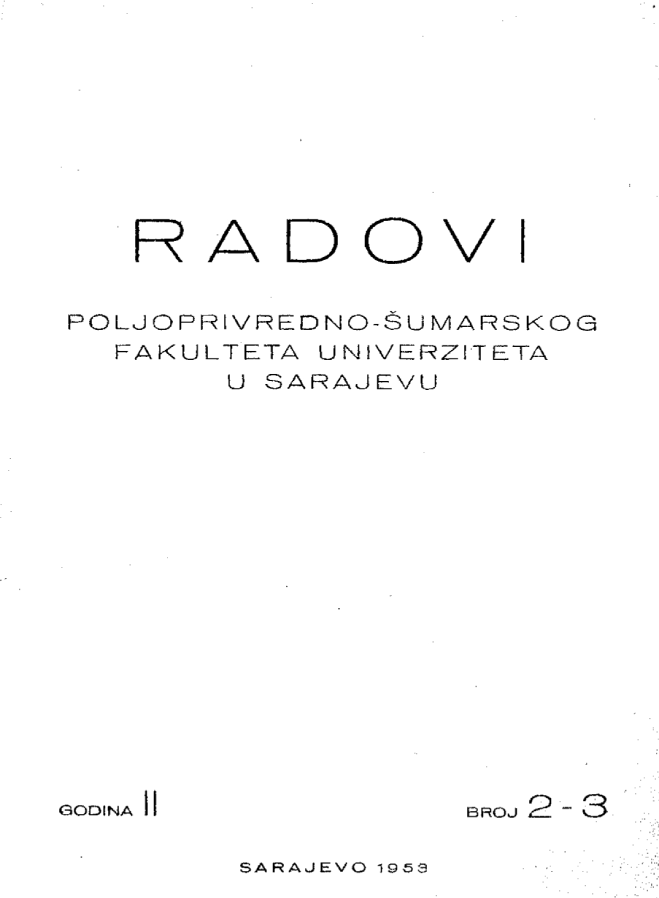PRILOG POZNAVANJU SASTAVA NAŠIH SIJENA
DOI:
https://doi.org/10.54652/rsf.1953.v2.i2-3.321Abstract
In the production and use of hay in Yugoslavia, the authors point out 3 essential negative factors which still predominate: (1) insufficient output, (2) imperfect production, hence poor quality, and (3) improper utilization, hence imperfect exploitation. It follows therefrom that, in seeking a solution of the problem of fodder crops and animal feeding-stuffs, the setting up of an
organization to ensure and safeguard adequate feeding of domestic animals is undoubtedly one among the first questions deserving consideration besides those concerned with measures for increasing the yield per a 'given unit of area and improving the technologic process of securing and preserving the produce of .foddercrops beating areas. Adequate planning and organizing
with the object of ensuring the proper feeding of domestic animals is not to be thought of without a thorough knowledge of nutritive values of animal feeding-stuffs.
The object of this report is to supply the data about the botanical and chemical composition of different kinds of hay gathered in the broad field of Gvozno, located in the southern part of the massif of the Treskavica Forest.
For experimental purposes, 8 samples of hay (1951) were made use of. Botanical analysis* of each standard sample disclosed the following groups:
(1) good fodder grasses, (2) leguminous plants, (3) good herbaceous plants, (4) acid grass, (5) useless herbs and harmful weeds, and (6) offal hay. Each of these groups has been tested for weight, the mean percentage of the total weight of each sample being given as well. The classification of the eight samples of hay, done according to Just, takes into account the percentage of good grasses and leguminous plants found: —- 1st class 75—100%,
.2nd class 50—75%, 3rd class 25—50%, and the 4th class 0—25%.
The results of botanical and chemical analyses (the latter by means of standard zootechnical methods) are shown in TABLES in the text.
Four of the eight samples gathered have proved unsatisfactory as regards their botanical composition, the content of good fodder grasses and; leguminous plants being under 50 percent. The remaining 4 samples have been found satisfactory (between 56,62 and 90,22 percent) except for the high percentage of offal and seeds, which latter indicates to the fact that the mowing was done rather late, at a time when the herbs were more or less past the flowering stage.
In the matter of raw protein content, the samples Nos 1, 7 and 8 are definitely poor, those numbered 5 and 6 only slightly less so, while No 2, 3 and 4 should be graded up to the category of good quality hay with a satisfactory average content of protein.
In order to produce a better quality of hay, thorough and large-scale improvements would have to be effected in a considerable part of the Gvozno area where there is a predominance of acid, inferior and harmful plants, chiefly of »Nardetum s t r i c t a e«. Admittedly, a work of this kind requires a great deal of time; however, the carrying out of preliminary measures for improving the technological process of grass-mowing and the storing of hay in optimum time would by itself, even in the present condition of the grass-covered area of Gvozno, be a good step towards the desired end.
Downloads
References
Batinica D.t Planinski, pašnjaci biljne zajednice »Nardetum strictae«.-Godišnjak Biološkog instituta u Sarajevu, god. II (1950) sv. 1—2, Sarajevo,
'
Handbuch der landw. Versuchs-Untersuchungsmethodik, Bd. III, —Berlin, 1941.
Honcamp F.: Die natürlichen pflanzlichen Futtermittel. Handbuch der Ernährung und des Stoffwechsels der landw. Nutztiere. Herausgegeben
von Ernst Mangold, I Bd., Berlin 1929.
Kapetanović S.: Mogućnosti izmjene nekih metoda u vezi sa hemijskom analizom sijena. Glasnik društva hemićara Nr. BiH-I, Sarajevo, 1952.
K e 11 n e r-F i n g e r 1 i n g: Grundziige der Füttererungslehre, Berlin, 1940
Maisurjan A.: Rastenievođstvo, Laboratornije zanjatija (rus.) , Moskva 1946.
Marković P.: Porovnâni botanückého a chemiôkého rozboru lu&mho sen-a.
Sboirnik Cehoslovenské Akademie Zemëdëlské Ročmk ХХИ, Sesit I, Praha, 1949.
Mohaček M.: Surova vlakna i njihovo određivanje u krmivima. Polj. znan. smotra, sv. 10/11 —- Zagreb 1947.
Nikolić S.: Praktikum iz agrikulturu© hernije, Beograd 1948.
Popov I.: Ishrana domaćih životinja (srp.), Beograd, 1949.
Popović J.: Ljetni stanovi (mahale) na planini Treskavici. Glasnik Zem, Muzeja BiH, XLV, Sarajevo, 1933.
Strelec P.: Prilog melioraciji travnjaka Nardetum, Veterinaria br. 5-6-7,.Sarajevo, 1952.
Smalcelj .: Pitanje krmne baze — njena rekonstrukcija i povećanje u vezi sa Petogodišnjim planom i perspektivnim razvitkom stočarstva. FNRJ. Referati I Savezne konferencije Zootehničara, Zagreb 1950.























